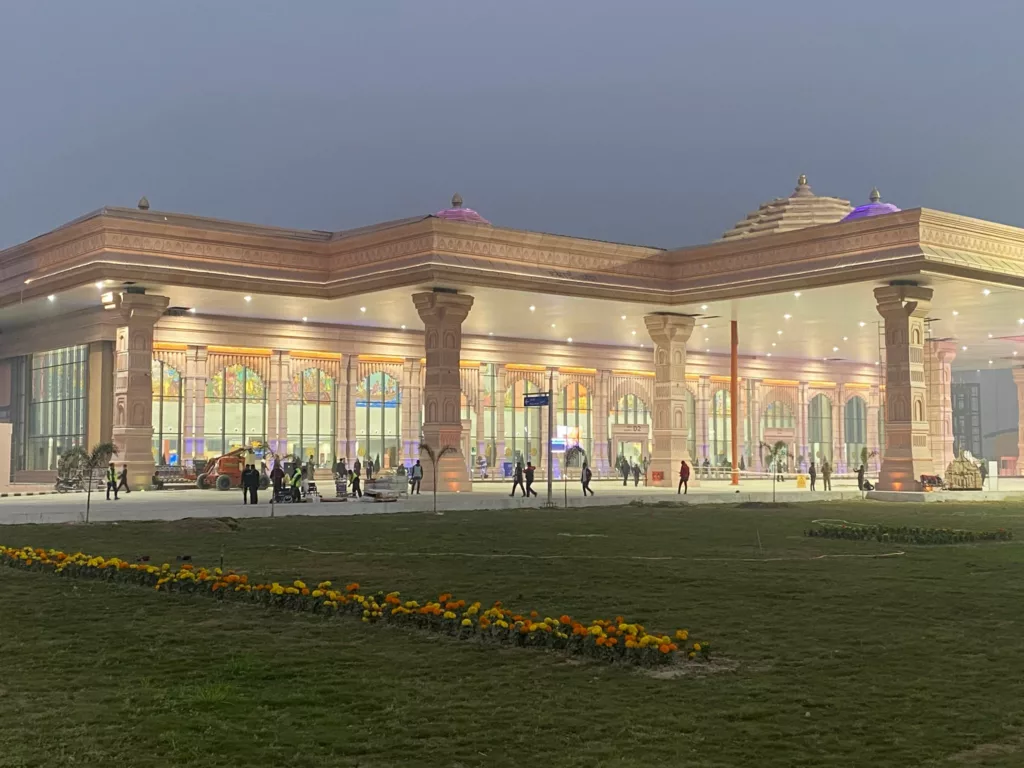Project Overview>
Ayodhya Airport, formally known as Maharishi Valmiki International Airport, Ayodhya Dham, is an international airport that serves the twin cities of Ayodhya and Faizabad in Uttar Pradesh, India. The airport is located near NH-27 and NH-330 in Naaka, Faizabad.With the recent opening of the Vallect has successfully completed the audiovisual (AV) needs for the Maharishi Valmiki International Airport in Ayodhya, improving the traveler experience. Installation of Flight Information Display Systems (FIDS), CCTV surveillance systems, Public Addressal (PA) systems, and complete audio solutions were all part of the project.
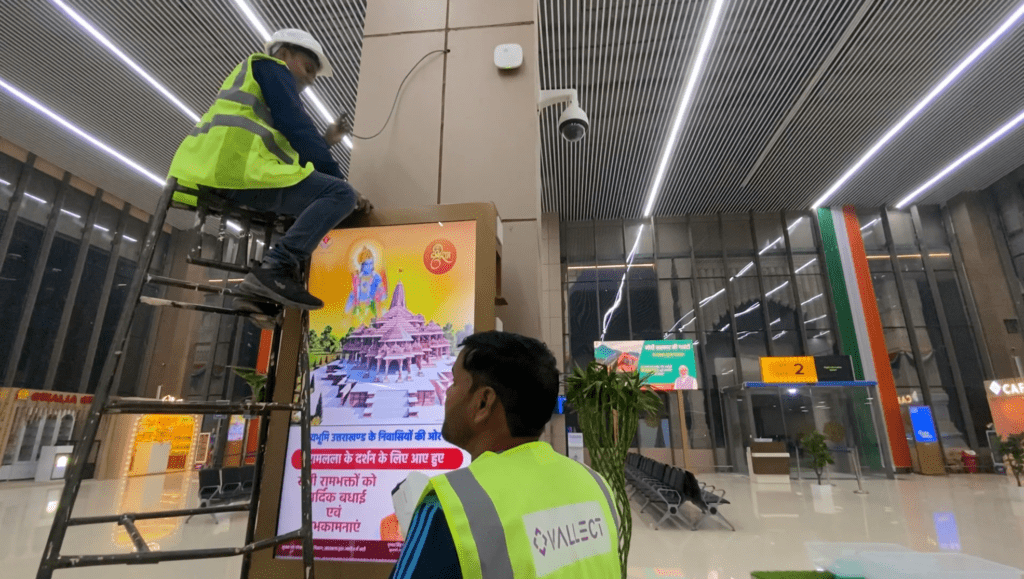
Our Solutions> Vallect's IT, CCTv, Pa & AV Brilliance: A Game-Changer for Ayodhya Airport
During a comprehensive site reconnaissance, Vallect observed the busy traffic and divided arrangement of the airport, which necessitated the thoughtful positioning of speakers, announcement systems, and digital displays. They made sure that safety regulations were followed and there was strong network connectivity. The integration of EPABX, IT infrastructure, visual displays, audio systems, and visual displays made sure the new systems were scalable for future requirements and compatible with the current infrastructure. It was also suggested that airport employees receive training on the new technology in order to ensure troubleshooting and smooth operations.
1: IP-Based CCTV System
Comprehensive IP-Based CCTV System Installation at Ayodhya Airport: Ensuring 100% Surveillance Coverage and Enhanced Security
An IP-based CCTV system at Ayodhya Airport is being designed, supplied, installed, tested, and commissioning (SITC) as part of this project. This integrated security management system includes various subsystems such as NVR-based CCTV Camera Solution, video surveillance software, monitors, operator workstations, and all necessary cabling and conduiting. The project also covers the comprehensive annual maintenance contract (CAMC) and adherence to the latest BCAS guidelines.
- Inventory Details-
| CCTV System for Terminal Building at Ayodhya Airport | |
| Description | |
| 1 | Indoor Dome Camera |
| 2 | Indoor Bullet Camera |
| 3 | Outdoor Bullet camera |
| 4 | Indoor /Outdoor PTZ Camera |
| 5 | IP Based Joystick Keyboard Controller |
| 6 | Server Based NVR |
| 7 | Network Storage Manager |
| 8 | Network Video Management and Monitoring Software |
Monitoring of the CCTV system shall be provided to all areas as mentioned below, as per AAI approved location and coverage area:
- City side
- Terminal Building Access points
- Screening of Registered Baggage
- BHS Conveyor bets
- Check-in-Counters
- Pre-embarkation Security check points
- Security Hold Area (SHA)
- Aerobridges/ Aerobridge tunnel
- Airside Entry Points through terminal buildings
- Access points to Airside through gates
- Baggage – make – Up Areas
System Features:
- Video Storage: Minimum 30 days at 25 FPS (720p) or 16 FPS (1080p), with 25% additional capacity
- Camera Types: Day/Night WDR Color Cameras, IR sensors for outdoor cameras
- Interoperability: Compatible hardware, OS, software, networking, and communication protocols
- Redundancy: Automatic fail-over to a redundant NVR
- Recording Parameters: Programmable frame rate and resolution
- Security: Tamperproof recording, programmable camera ID, location, date/time stamp
- Expansion: Future system expansion with off-the-shelf hardware
This CCTV system aims to provide comprehensive surveillance, ensuring no dark spots and maintaining a secure environment at Ayodhya Airport.
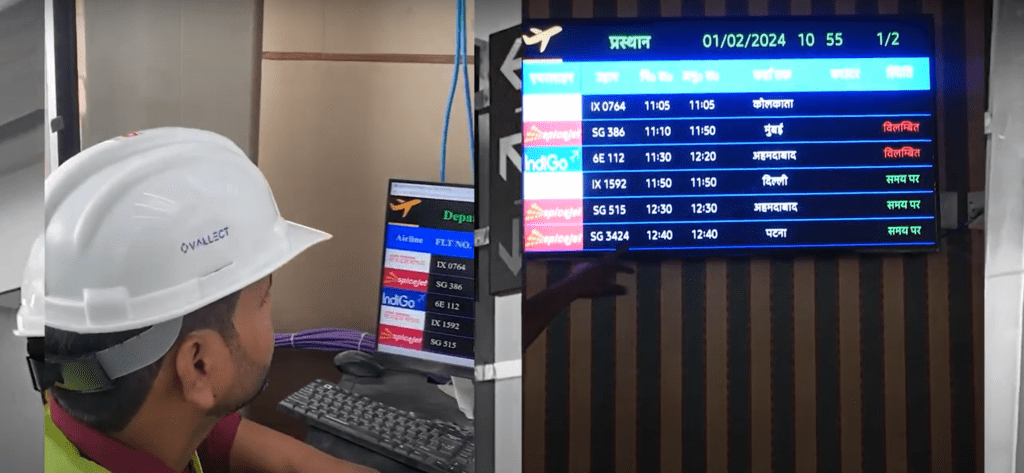
2:- Flight Information Display System (FIDS)
Implementation of Flight Information Display System (FIDS) at Ayodhya Airport
The Ayodhya Airport requires a state-of-the-art Flight Information Display System (FIDS) to provide passengers with up-to-date information on flights, baggage, gates, and other critical airport services. This case study outlines the scope of work, inventory list, functional parameters, and key considerations for the successful implementation of the FIDS.
The project involves the design, supply, installation, testing, and commissioning of a complete FIDS. The primary objectives include:
- Design and Integration:
- Develop a comprehensive FIDS that integrates application software, databases, display units, networking components, and necessary cabling.
- Ensure the system is modular, allowing for easy maintenance and future upgrades.
- Supply and Installation:
- Provide and install 43” and 55” UHD professional displays, interactive touch screen kiosks, video walls, and necessary mounting brackets.
- Supply and set up networking components, including edge switches, SFP modules, and patch panels.
- Testing and Commissioning:
- Conduct thorough testing of all system components per OEM guidelines.
- Commission the system with certified engineers to ensure proper functioning and integration.
- Maintenance:
- Offer comprehensive annual maintenance contracts (CAMC) to ensure the system remains operational and up-to-date.
- Power Backup:
- Supply an online UPS to provide a minimum of 30 minutes of power backup at full load.
Inventory List
| S.No | Flight Information Display System for Terminal Building at Ayodhya Airport |
| 1 | 43″ 4k UHD Professional Display with 500 nit’s brightness |
| 2 | 55″ 4k UHD Professional Display with 500 nit’s brightness |
| 3 | 22″ Interactive Touch screen kiosk for data entry terminal |
| 4 | Flight Information Display Software |
| 5 | SFP Module |
| 6 | Equipment Rack- 24U |
Functional Parameters of FIDS-
- The Flight Information Display System (FIDS) has been installed at various locations for providing
- Passenger Information
- Flight Information
- Baggage Belt Information
- Check In-Counter information
- Boarding Gate Information
- Departure information
- Arrival information
Kiosk that can hold a minimum of a 21-inch screen, a single metallic keyboard with a trackpad, enough room for the CPU, UPS, and PDU (power distribution unit for powering all equipment with two spare 6A power connectors), and can be accessed from the back door. The entire design will be modular, with replaceable and interchangeable components. For accessibility and maintenance purposes, the display screen must have a separate door, and all locks must have a two-point locking system.
Introduction
- The offered equipment is compact, fully solid state, highly reliable and shall use latest state of the art technology.
- The design and selection of the offered equipment has been with the requirements of long-term trouble-free operation with highest degree of reliability and maintainability.
- The offered equipment designed for continuous operation (24 hours a day and 365-days a year) as per Airport design consideration.
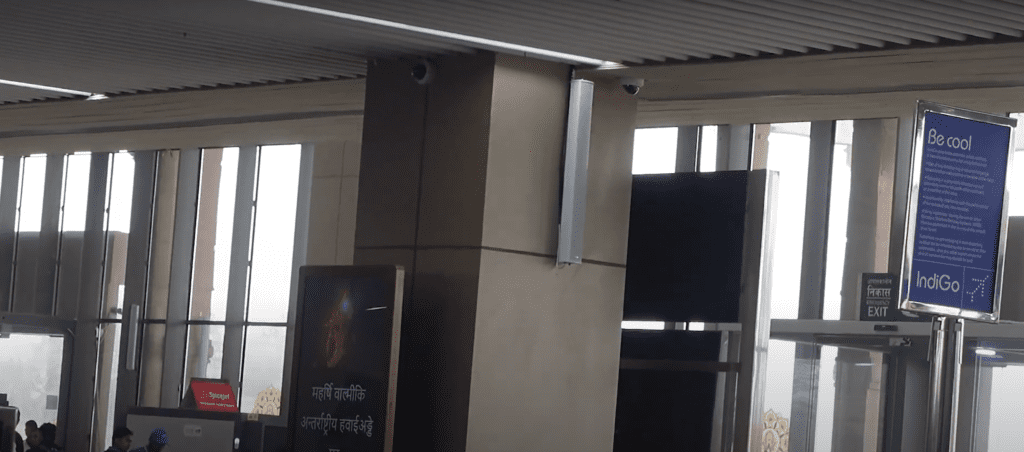
3:Public Addressal & Voice Alarm (PAVA)
Implementation of Public Addressal & Voice Alarm (PAVA) System at Ayodhya Airport
The Ayodhya Airport requires a modern Public Addressal & Voice Alarm (PAVA) system to handle flight, general, and emergency announcements effectively. This system is crucial for ensuring clear communication and safety within the new terminal building and surrounding areas. This case study outlines the scope of work, inventory list, functional parameters, and key considerations for the successful implementation of the PAVA system.
The project involves the design, supply, installation, testing, and commissioning of a PAVA system, with the following primary objectives:
Design and Integration:
- Develop a comprehensive PAVA system integrating IP and microprocessor-based audio processors with public address sound management.
- Incorporate both manual and automatic announcement capabilities.
Supply and Installation:
- Provide and install various types of speakers, amplifiers, digital call stations, and other necessary equipment.
- Set up a car calling audio system for the parking area integrated with the main PA system.
Testing and Commissioning:
- Conduct thorough testing of all system components per OEM guidelines.
- Commission the system with certified engineers to ensure proper functioning and integration.
Maintenance and Redundancy:
- Ensure the system has redundancy features and is capable of continuous operation.
- Offer comprehensive annual maintenance contracts (CAMC) to ensure the system remains operational and up-to-date.
System Features:
- Provide background and foreground music capabilities.
- Implement fire alarm integration where emergency announcements override all other functions.
- Enable different background music in different zones.
Inventory List
| PA System for Terminal Building at Ayodhya Airport |
1 | IP Based Public Address Sound Management system with dedicated Hot stand by (1+1) Network controller |
2 | PC control GUI Software |
3 | PC Based Music Player |
4 | Equipment Rack |
5 | Power Amplifier |
Functional Parameters
The PAVA system is designed to meet the following functional requirements:
Speech Intelligibility:
- Ensure undistorted speech reproduction with an SPL of 75 dB (peak up to 97 dB) at listening level.
- Monitor all system components digitally, including messages, amplifiers, speaker circuits, and more.
Automatic and Manual Messaging:
- Automatically send messages to any zone without affecting music in other areas.
- Override all other PA operations in the event of a fire alarm.
Modular Design:
- The system should be modular for ease of maintenance and future expansion.
- Avoid echo during announcements using feedback suppressors and audio processors.
Zoning:
- Divide the terminal building into a maximum of 12 zones, initially as follows:
- Zone 1: Public Concourse, Curb Area city side
- Zone 2: Check-in and Pre SHA
- Zone 3: Security Hold Area, Bus Lounge, and Baggage Make-up area
- Zone 4: Departure, VIP Lounge, and Cafeteria
- Zone 5: Arrival, Baggage claim, and Break-up area
- Zone 6: Car calling area
System Design and Implementation
To implement the PAVA system effectively, the following steps will be taken:
System Design and Planning:
- Conduct a thorough site survey to determine optimal locations for speakers and call stations.
- Design the network architecture, including cabling routes and equipment placement.
Equipment Installation:
- Install IP-based public address sound management systems, amplifiers, speakers, and other components as per the design plan.
- Set up digital call stations and car call consoles.
Software Configuration:
- Install and configure the PAVA control software on the server.
- Set up the music player and configure the system for different zones.
Testing and Validation:
- Perform comprehensive testing of all system components.
- Validate the integration of speakers, amplifiers, and control software to ensure accurate and timely announcements.
Training and Handover:
- Train airport staff on using and maintaining the PAVA system.
- Provide documentation and support for ongoing system operation.
Ayodhya Airport is implementing a PAVA system, ensuring work adheres to parameters and ensures a reliable and efficient system for communication and safety.
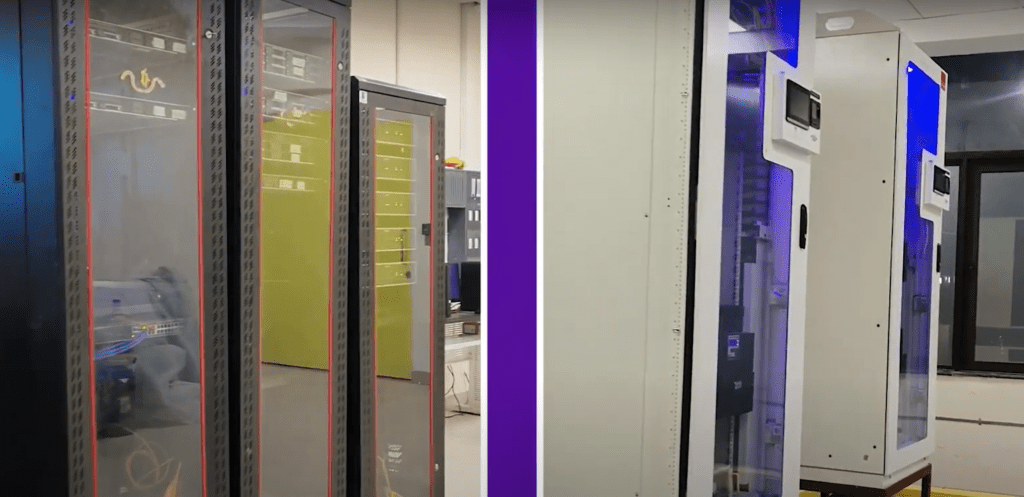
4: Airport IT Network Infrastructure
Implementation of IT System at Ayodhya Airport
The Ayodhya Airport requires a comprehensive IT system to support various applications and services. This document outlines the inventory list, functional parameters, and key considerations for the successful implementation of the IT system.
Robust and Redundant IT System Implementation for Ayodhya Airport
The project involves the design, installation, testing, and commissioning of the IT system, including both active and passive components, to ensure robust and redundant connectivity across the airport campus.
Passive Cabling Works:
- Provide Integrated Local Area Network (LAN) for voice, data, and video requirements.
- Use CAT 6A or latest passive cables for connectivity.
- Lay OFC backbone, UTP, and voice cabling; install racks, conduits, cable trays, and raceways.
Active Networking Equipment:
- Supply and install routers, firewalls, core and distribution switches in High Availability (HA) mode.
- Ensure redundant power supply and UPS power for 24×7 operation.
- Provide PoE+ switches for wireless access points, CCTV, and other applications.
- System Integration:
- Establish WAN, LAN, and WLAN for all applications, including biometric access control.
- Ensure centralized control, provisioning, and management via a wireless controller.
Redundancy and Reliability:
- Implement fiber and UTP cabling with redundancy.
- Design for 24×7 operation with high availability.
Inventory List
| IT Active System for Terminal Building at Ayodhya Airport | |
| 1 | Core Cum distribution switch in HA mode |
| 2 | Wireless Controller in HA mode |
| 3 | Indoor Access point |
| 4 | Stacking Cable with pair stacking module |
| 5 | NMS- Network Management software |
| IT Passive System for Terminal Building at Ayodhya Airport | |
| 1 | 24 core Fiber LIU Loaded |
| 2 | 6 Port LIU Loaded |
| 3 | LC-LC OS2 Patch cord |
| 5 | Cat6A Jack panel Loaded |
Functional Parameters
Access Network:
- 24 and 48-port PoE+/non-PoE switches provide 1G connectivity.
- 10G uplink ports for switches to distribution network.
Core Network:
- High availability with Layer-3/4 Gigabit Ethernet switches.
- 40G interconnect for Layer-3 forwarding and quality control.
Firewall and Wireless Controller:
- Secure connectivity for AAI WAN.
- Centralized control of the wireless network.
Structured Cabling:
- Use CAT 6A UTP for all user nodes.
- Fiber cable supports 10G and 40G transmission with redundancy.
Installation Standards
- Performed by technically qualified and certified engineers.
- Neat and clean rack connectivity for reliability.
- Police verification and airport entry permits for installation personnel.
Challenges>
During the installation of the IP-based CCTV system, FIDS (Flight Information Display System), PA (Public Addressable) systems, and audio solutions at Ayodhya Airport, the Vallect team encountered several significant challenges.
- Time Constraints:
The Vallect team had only 3 months to install lots of systems [IP-based CCTV system, FIDS (Flight Information Display System), PA (Public Addressable) systems, and audio solutions ]. They worked really hard, planning carefully and working non-stop day and night for a whole month. Even though it was tough, they stayed strong and helped each other out. Finally, they finished on time! It showed that when people work together and never give up, they can achieve anything.
- Manpower Shortages:
The scarcity of technical manpower posed a persistent challenge throughout the project. To address this, the Vallect team optimized workforce allocation and schedules, ensuring that each system’s installation proceeded smoothly despite resource limitations. Effective resource management maintained momentum and quality in the work.
- Vendor Dependencies:
Coordinating with various vendors for electrical, civil, and infrastructure work was vital for the project’s success. Clear communication and collaboration were essential to align all aspects seamlessly. Proactively managing dependencies and fostering strong vendor relationships, the Vallect team navigated potential bottlenecks and ensured a streamlined installation process.
In overcoming these challenges, the Vallect team successfully led the project to its completion, delivering an integrated security and operational infrastructure that enhances safety and efficiency at Ayodhya Airport.
Customer Benefits
Vallect’s solutions enhance security, improve passenger experience, and boost operational efficiency at Ayodhya Airport. Enhanced Security:- Comprehensive Coverage: 100% surveillance with advanced IP-based CCTV, eliminating dark spots.
- Reliability: Redundant systems ensure continuous operation.
- Real-Time Info: Up-to-date flight and baggage information through state-of-the-art FIDS.
- User-Friendly: Interactive touch screens and UHD displays for easy access to information.
- Clear Announcements: High-quality PAVA system for clear messages.
- Emergency Integration: Automatic emergency announcements ensure safety.
- Reliable Connectivity: 24×7 robust and redundant network connectivity.
- Centralized Management: Efficient management of WAN, LAN, and WLAN with enhanced security.
- Seamless Integration: Harmonious operation of AV, IT, and security systems.
- Scalability: Easy future upgrades and expansion.
- CAMC: Comprehensive maintenance contracts keep systems operational and up-to-date.
- Future-Proofing: Modular design and off-the-shelf hardware for long-term savings.
Customer Experience>
Working with Vallect has been a game-changer for the Maharishi Valmiki International Airport. Their team’s dedication and expertise were evident from day one, and they managed to deliver all the systems within an incredibly tight schedule. The enhancements in our surveillance, information display, public address, and IT systems have transformed the operational efficiency and security of our airport. We are now well-equipped to handle the increased traffic and provide a superior experience to our passengers. Vallect’s ability to overcome significant challenges and deliver high-quality solutions is commendable. Their efforts have undoubtedly set a new standard for airport infrastructure projects.
"Vallect's knowledge and commitment have taken our airport to new heights and established a standard for excellence in airport information technology solutions."

